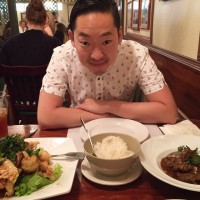The Asian American experience is an essential thread in the rich and ever-shifting fabric of American history and culture. We have laid railroad tracks, worked plantation fields, fought for civil rights and engineered technological miracles. Ours is an impossibly varied experience, with nuances born of geographic and temporal difference, neither easily parsed nor ever fully captured.
CAAM has partnered with AT&T to bring #StoriestoLight, a community storytelling campaign highlighting the diverse perspectives and experiences that comprise the APA community. From May and into August, continue to view and experience the rich collage of APA voices and images here with a new chapter every two weeks.
CHAPTER FOUR
This installment introduces some of the hard working staff members of CAAM. Read their thoughts on how food impacts their identity and community and their earliest food memories.
Ashlyn Perri, Digital and Interactive Media Associate
 Food has always been an important part of my upbringing. With a Japanese mother and an Italian-American father, the table would always be an eclectic mix of Japonica-Italian delights. On special occasions, a coursed menu at a Japalian dinner table would go as follows:
Food has always been an important part of my upbringing. With a Japanese mother and an Italian-American father, the table would always be an eclectic mix of Japonica-Italian delights. On special occasions, a coursed menu at a Japalian dinner table would go as follows:
Antipasto:
Chawanmushi with shiitake, chicken, and water chestnuts
Primo Piatto:
Udon with grandma’s pork neck bone marinara
Secondo Piatto:
Dad’s Homemade pizza with sausage, tomato, and shishito peppers
Dolce:
Canoli and genmaicha
Masashi Niwano, Festival and Exhibitions Director
 Food, like media has significantly impacted my personal identity and sense of community. It doesn’t matter who I’m with or what the situation is, food always comes up in conversation. In my spare time, I love throwing dinner parties. I spend hours thinking about what I want to make and equally what would my friends enjoy eating. My inspiration starts with my own experiences, so most dishes are infused with Japanese cuisine. Here’s some of my recent culinary offerings:
Food, like media has significantly impacted my personal identity and sense of community. It doesn’t matter who I’m with or what the situation is, food always comes up in conversation. In my spare time, I love throwing dinner parties. I spend hours thinking about what I want to make and equally what would my friends enjoy eating. My inspiration starts with my own experiences, so most dishes are infused with Japanese cuisine. Here’s some of my recent culinary offerings:Phallina Kuch, Festival Intern
 Food surrounded my life growing up more ways than one. My family owned a Chinese restaurant in a small Georgia town. I ate Chinese all day, but my favorite dishes weren’t always on the menu. Of all the hundred items my dad knew how to make, he always loved to innovate and experiment with new dishes that were fusions of Cambodian and Chinese. One of his favorite and off-menu item was a lemon pepper steak. It was sour, yet sweet, seasoned all around with black pepper. He charred it on the outside, but somehow left it nice and pink in the middle. It was perfect. I’d ask him how to make it, and he’d simply tell me, “It’s all in how you use the wok.”
Food surrounded my life growing up more ways than one. My family owned a Chinese restaurant in a small Georgia town. I ate Chinese all day, but my favorite dishes weren’t always on the menu. Of all the hundred items my dad knew how to make, he always loved to innovate and experiment with new dishes that were fusions of Cambodian and Chinese. One of his favorite and off-menu item was a lemon pepper steak. It was sour, yet sweet, seasoned all around with black pepper. He charred it on the outside, but somehow left it nice and pink in the middle. It was perfect. I’d ask him how to make it, and he’d simply tell me, “It’s all in how you use the wok.”
Debbie Ng, Director of Development & Communications
 Growing up in a Chinese immigrant household in Sacramento, one of my first and fondest food memories is of my mom brewing medicinal broths also known as “tong” in Cantonese. She’d spend the entire day simmering pork bones with Chinese roots and fungus, filling the kitchen with a warm, herbal steam. When ready, she’d ladle the broth into 6 rice bowls, one for each of my family members, and call us into the kitchen to drink before dinner. Over the years, mom would have tong prepared as soon as I walked in the door or she’d send me off with old Prego jars filled with the broth to tide me over until the next visit home.
Growing up in a Chinese immigrant household in Sacramento, one of my first and fondest food memories is of my mom brewing medicinal broths also known as “tong” in Cantonese. She’d spend the entire day simmering pork bones with Chinese roots and fungus, filling the kitchen with a warm, herbal steam. When ready, she’d ladle the broth into 6 rice bowls, one for each of my family members, and call us into the kitchen to drink before dinner. Over the years, mom would have tong prepared as soon as I walked in the door or she’d send me off with old Prego jars filled with the broth to tide me over until the next visit home.




